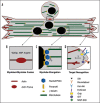Cytoskeletal remodeling during myotube assembly and guidance: coordinating the actin and microtubule networks
- PMID: 19907716
- PMCID: PMC2775249
- DOI: 10.4161/cib.2.5.9158
Cytoskeletal remodeling during myotube assembly and guidance: coordinating the actin and microtubule networks
Abstract
The formation of a multinucleated muscle fiber from individual myoblasts is a complex morphological event that requires dramatic cytoskeletal rearrangements. This multistep process includes myoblast fusion, myotube migration and elongation, myotube target recognition, and finally attachment to form a stable adhesion complex. Many of the studies directed towards understanding the developmental process of muscle morphogenesis at the cellular level have relied on forward genetic screens in model systems such as Drosophila melanogaster for mutations affecting individual stages in myogenesis. Through the analyses of these gene products, proteins that regulate the actin or microtubule cytoskeleton have emerged as important players in each of these steps. We recently demonstrated that RacGAP50C, an essential protein that functions as a cytoskeletal regulator during cell division, also plays an important role in organizing the polarized microtubule network in the elongating myotube. Here we review the current literature regarding Drosophila myogenesis and illustrate several steps of muscle development with respect to the diverse roles that the cytoskeleton plays during this process. Furthermore, we discuss the significance of cytoskeletal coordination during these multiple steps.
Keywords: actin; cytoskeleton; microtubule; muscle; myotube guidance.
Figures

Similar articles
-
RacGAP50C directs perinuclear gamma-tubulin localization to organize the uniform microtubule array required for Drosophila myotube extension.Development. 2009 May;136(9):1411-21. doi: 10.1242/dev.031823. Epub 2009 Mar 18. Development. 2009. PMID: 19297411 Free PMC article.
-
Noncanonical roles for Tropomyosin during myogenesis.Development. 2015 Oct 1;142(19):3440-52. doi: 10.1242/dev.117051. Epub 2015 Aug 20. Development. 2015. PMID: 26293307
-
Diaphanous regulates SCAR complex localization during Drosophila myoblast fusion.Fly (Austin). 2016 Oct;10(4):178-86. doi: 10.1080/19336934.2016.1195938. Epub 2016 Jun 17. Fly (Austin). 2016. PMID: 27314572 Free PMC article.
-
Drosophila comes of age as a model system for understanding the function of cytoskeletal proteins in cells, tissues, and organisms.Cytoskeleton (Hoboken). 2015 May;72(5):207-24. doi: 10.1002/cm.21228. Epub 2015 Jun 30. Cytoskeleton (Hoboken). 2015. PMID: 26074334 Free PMC article. Review.
-
Mechanisms regulating myoblast fusion: A multilevel interplay.Semin Cell Dev Biol. 2020 Aug;104:81-92. doi: 10.1016/j.semcdb.2020.02.004. Epub 2020 Feb 13. Semin Cell Dev Biol. 2020. PMID: 32063453 Review.
Cited by
-
Reduced myotube diameter induced by combined inhibition of transforming growth factor-β type I receptors Acvr1b and Tgfbr1 is associated with enhanced β1-syntrophin expression.J Cell Physiol. 2024 Dec;239(12):e31418. doi: 10.1002/jcp.31418. Epub 2024 Aug 20. J Cell Physiol. 2024. PMID: 39164996 Free PMC article.
-
WAVE2 Is a Vital Regulator in Myogenic Differentiation of Progenitor Cells through the Mechanosensitive MRTFA-SRF Axis.Cells. 2023 Dec 20;13(1):9. doi: 10.3390/cells13010009. Cells. 2023. PMID: 38201213 Free PMC article.
-
Palmitic Acid-Induced miR-429-3p Impairs Myoblast Differentiation by Downregulating CFL2.Int J Mol Sci. 2021 Oct 11;22(20):10972. doi: 10.3390/ijms222010972. Int J Mol Sci. 2021. PMID: 34681631 Free PMC article.
-
A nuclear localization signal is required for the nuclear translocation of Fign and its microtubule‑severing function.Mol Med Rep. 2020 Jun;21(6):2367-2374. doi: 10.3892/mmr.2020.11040. Epub 2020 Mar 26. Mol Med Rep. 2020. PMID: 32236575 Free PMC article.
-
Matrix produced by diseased cardiac fibroblasts affects early myotube formation and function.Acta Biomater. 2022 Oct 15;152:100-112. doi: 10.1016/j.actbio.2022.08.060. Epub 2022 Aug 31. Acta Biomater. 2022. PMID: 36055608 Free PMC article.
References
-
- Bate M. The embryonic development of larval muscles in Drosophila. Development. 1990;110:791–804. - PubMed
-
- Dohrmann C, Azpiazu N, Frasch M. A new Drosophila homeo box gene is expressed in mesodermal precursor cells of distinct muscles during embryogenesis. Genes Dev. 1990;4:2098–2111. - PubMed
-
- Ruiz-Gomez M, Romani S, Hartmann C, Jackle H, Bate M. Specific muscle identities are regulated by Kruppel during Drosophila embryogenesis. Development. 1997;124:3407–3414. - PubMed
-
- Bate M, Rushton E. Myogenesis and muscle patterning in Drosophila. C R Acad Sci III. 1993;316:1047–1061. - PubMed
LinkOut - more resources
Full Text Sources
Molecular Biology Databases
